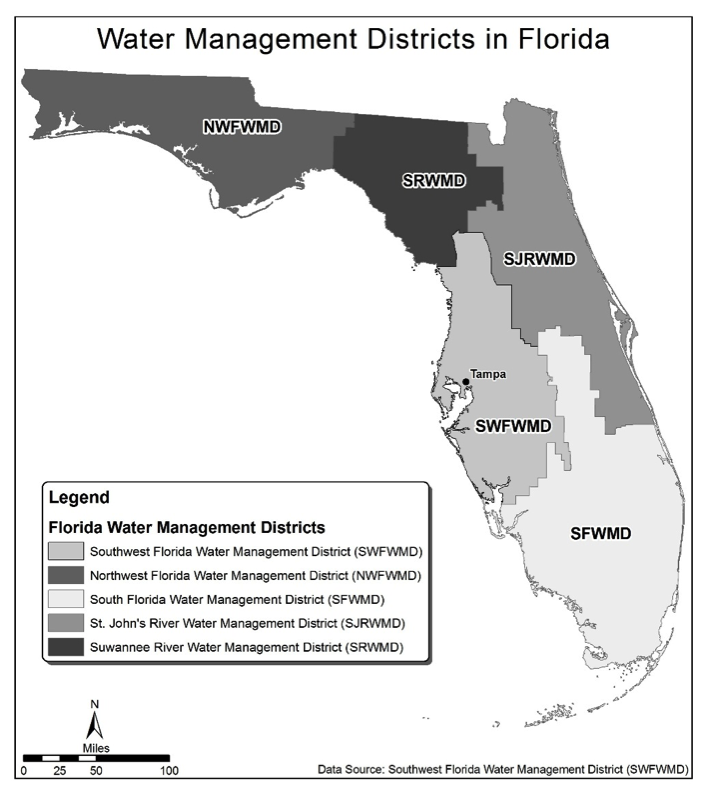Water, Growth and Tampa Bay
Florida is practically synonymous with water and at first blush it seems inconceivable that the Sunshine State could have water problems typical of drier western states. After all, Florida averages 54 inches of rainfall each year and despite more than a century of drainage, it still has more acres of wetlands than any state except Alaska. It also has nearly 8,000 lakes at least one acre in extent, more than 1,700 streams of all lengths and widths, and it is underlain by the Floridan aquifer, one of the most productive groundwater formations in the world. Given this, it probably comes as no surprise that peninsular Florida has more than 700 springs—the largest concentration of freshwater springs in the world. Indeed, for much of Florida’s history, people have struggled with too much water.
By the 1970s, however, rapid population growth in the Tampa Bay region and elsewhere stressed the state’s water resources. In response, the Florida legislature created five water management districts (WMDs), encompassing the entire state (figure 1). Water management district boundaries are based on surface water hydrologic divides, which is better than political boundaries, but less helpful in a state dominated by groundwater use. Florida’s water management districts are quasi state agencies, under the supervision of the Florida Department of Environmental Protection—and the state constitution demands that they manage water resources sustainably while accommodating all current and future uses (at best, a difficult balancing act).

As is true for the rest of Florida, growth and development in the greater Tampa Bay region has long depended on water control. For nearly a century, the City of Tampa has tapped the Hillsborough River as a water supply. As late as the 1960s, flooding along portions of the 54-mile Hillsborough River remained the most critical water issue in Tampa. Meanwhile, continued population growth throughout the region, especially on the western side of Tampa Bay (in Pinellas County, featuring St. Petersburg and Clearwater; Figure 2), relied on access to inexpensive but high quality groundwater. Saltwater intrusion into Pinellas County well fields has been a problem since the 1920s, so Pinellas authorities ultimately bought land for well fields in rural but inland portions of neighboring Pasco and Hillsborough counties. Yet by the 1980s, many people living in these rural areas began to see the negative impacts of excessive groundwater pumping. Specifically, wetlands and lakes began drying up, much to the chagrin of property owners who built docks and boathouses that eventually extended to dry land.
While some officials blamed drought for disappearing surface water, the Southwest Florida Water Management District (often called Swiftmud) eventually demanded that Pinellas utilities reduce groundwater pumping. Swiftmud’s stance threatened the region’s growth coalition: politicians, realtors, home builders and other business leaders who believed that continued access to inexpensive groundwater remained vital to sustain continued population growth and economic development. After more than a decade of costly political and legal wrangling between Swiftmud and Pinellas County leaders (known locally as the Tampa Bay Water Wars), a settlement finally emerged in 1997. Swiftmud agreed to help a new regional water wholesaler (Tampa Bay Water) build new and expensive water infrastructure that would eventually reduce the pressure on groundwater resources while accommodating future growth and development.

As a result, Tampa Bay is now home to the largest desalination plant in the western hemisphere (even if water managers in California may soon claim this distinction). Plagued by serious technical problems and cost overruns, the $158 million plant finally achieved peak production of 25 million gallons per day (mgd) in late 2007. To put this in perspective, the three Tampa Bay area counties of Hillsborough, Pinellas and Pasco used 432 mgd of fresh water in 2005. Despite the advantages of flat topography (which keeps distribution costs low compared to regions with more hilly topography), drawing water from the Tampa Bay estuary (which is somewhat less salty than sea water, so it reduces treatment costs), and a location adjacent to a power plant that discharges higher temperature water used for cooling (further reducing treatment costs)—despite these advantages, the desalination plant often operates well below capacity because it produces water that costs more than other sources.
That is not all. Swiftmud also agreed to subsidize the construction of the 15 billion gallon C.W. Bill Young Regional Reservoir that would store excess surface water from local streams during the summer rainy season for use during the region’s relatively dry winter and spring. This $146 million facility developed cracks soon after opening in 2005, and, after spending several million dollars trying to make repairs and suing the original contractor, not only did Tampa Bay Water lose the lawsuit but its customers now have to pay $129 million to rebuild the reservoir. Finally, Tampa Bay Water also spent $144 million on a surface water treatment facility, which makes potable water from a variety of surface sources including the broken reservoir, the desalination plant, and local streams. Like the other projects, this treatment plant experienced problems at first, but is now functioning properly.
On top of all of this, several Tampa Bay communities continue to invest millions of dollars laying pipes and building pump stations to distribute treated wastewater from sewage treatment plants (often called reclaimed water) for use in irrigating golf courses, parks, and yards, as well as for industrial and limited agricultural use. Making use of treated wastewater is not only drought resistant, it reduces the use of drinking water for growing grass. In 1977, Tampa’s neighbor, St. Petersburg, initiated the first large urban water reuse system in the United States. Florida (along with California) leads the nation in its use of reclaimed water; data from a May 2013 Florida Department of Environmental Protection report show that the Sunshine State now reuses about 45% of treated wastewater discharged from sewage treatment plants. Similarly, Swiftmud contends that 44% of all the treated wastewater leaving sewage treatment plants in the district is now reused.
For Tampa Bay and most of the rest of Florida, authorities are already making maximum use of inexpensive groundwater, and they have begun to tap more expensive water in order to continue fanning the flames of population growth and development. Few would argue with calls to reduce water use by using water more efficiently. Yet many people are annoyed that they have to reduce their water use in order to provide water to support continued development. Worse, major water utilities investing in expensive infrastructure depend on a certain level of water sales to pay for such infrastructure; when people buy less water (conserve!), utilities often have to charge more (per unit) for what they sell. In the U.S., costs associated with public water provision are often distributed evenly among a population, with the occasional exception of instituting progressively higher rates for larger amounts of consumption/use. Certainly those who benefit the most from constant population and economic growth favor this approach. What might make more sense, however, is assigning a larger percentage of the cost of developing more expensive sources of water to those who create that need in the first place. Regardless, future water use will almost certainly be more expensive; the remaining questions are how much will it cost and who will foot the bill?
Christopher Meindl
University of South Florida – St. Petersburg
Maps by Andy Hayslip
University of South Florida – St. Petersburg
Further Reading
Cynthia Barnett. 2007. Mirage: Florida and the Vanishing Water of the Eastern U.S. Ann Arbor: University of Michigan Press.
Nelson M. Blake, Christopher F. Meindl, Steven Noll, and David Tegeder. 2010 (2nd edition). Land Into Water, Water Into Land: A History of Water Management in Florida. Gainesville: University Press of Florida.
Elizabeth D. Purdum, Peter A. Kraft, Edward A. Fernald, and James R. Anderson (eds.). 1998. Water Resources Atlas of Florida. Tallahassee: Florida State University, Institute of Science and Public Affairs.
John T. Scholz and Bruce Stiftel. 2005. Adaptive Governance and Water Conflict: New Institutions for Collaborative Planning. London: Routledge.
Tom Swihart. 2011. Florida’s Water: A Fragile Resource in a Vulnerable State. Washington, DC: Resources for the Future Press.


